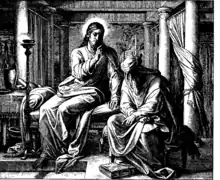Nicodemite
A nicodemite is a person suspected of publicly misrepresenting their religious faith to conceal their true beliefs.[1][2]
The term is normally disparaging. It was introduced into 16th century religious discourse, and persisted in use into the 18th century and beyond. It was usually applied to persons of publicly conservative religious position and practice who were thought to be secretly humanistic or reformed. Originally employed mostly by Protestants, it was later also used by Catholics.[3]
Friedrich Heer in his book The Medieval World refers to the 12th century circle at Chartres as past masters of nicodemism which he describes as "dangerous thoughts, dangerous allusions to topical ecclesiastical and political affairs, and above all to ideas hard or impossible to reconcile with the dogma of the Church or the maxims of the prevailing theology".[4]
In England during the 17th and 18th centuries it was often applied to those suspected of secret Socinian, Arianist, or proto-Deist beliefs.[5]
Origin

The term was apparently introduced by John Calvin (1509–1564) in 1544 in his Excuse à messieurs les Nicodemites.[6] Since the French monarchy had increased its prosecution of heresy with the Edict of Fontainebleau (1540), it had become increasingly dangerous to profess dissident belief publicly, and refuge was being sought in emulating Nicodemus.
In the Gospel of John (John 3:1-2) there appears the character Nicodemus, a Pharisee and member of the Sanhedrin. Although outwardly remaining a pious Jew, he comes to Jesus secretly by night to receive instruction. Although he was eventually made a saint, his dual allegiance was somewhat suspect.
There was a man of the Pharisees, named Nicodemus, a ruler of the Jews: The same came to Jesus by night, and said unto him, Rabbi, we know that thou art a teacher come from God: for no man can do these miracles that thou doest, except God be with him.
Notable suspected Nicodemites
- Edward Courtenay, 1st Earl of Devon (c. 1527-1556), courtier of Mary I of England[7]
- Thomas Cranmer (1489–1556), first Anglican Archbishop of Canterbury under Henry VIII of England[8]
- Michelangelo (1475-1564), who sculpted a self-portrait of himself as Nicodemus in his Florentine Pietà[9]
- Isaac Newton (1643–1727), eminent scientist and theologian[10]
- Reginald Cardinal Pole (1500–1558), last Roman Catholic Archbishop of Canterbury[11]
See also
References
- Overell 2004, pp. 117-118.
- Livingstone 2000
- Overell 2004 p. 118, notes 4 and 5.
- Friedrich Heer "The Medieval World" Cardinal London 1974 page 114
- Snobelen 1999.
- Eire 1979
- Overell 2008, passim.
- Overell 2008, p. 207.
- Shrimplin-Evangelidis 1989.
- Snobelen 1999.
- Overell 2008, p. 7.
Bibliography
- Ginzburg, Carlo "Il nicodemismo. Simulazione e dissimulazione religiosa nell'Europa del Cinquecento", Einaudi, Torino 1970
- Eire, Carlos M. N. "Prelude to Sedition: Calvin's Attack on Nicodemism and Religious Compromise". Archiv für Reformationsgeschichte 76:120-45.
- Eire, Carlos M. N. "Calvin and Nicodemism: A Reappraisal". Sixteenth Century Journal X:1, 1979.
- Livingstone, E. A. "Nicodemism". In The Concise Oxford Dictionary of the Christian Church. Oxford University Press, Oxford, 2000. Entry available here.
- Overell, M. Anne Italian Reform and English Reformations, c.1535–c.1585. The Open University, UK. 2008. Excerpt available online.
- Overell, Anne. "A Nicodemite in England and Italy: Edward Courtenay, 1548-46". In John Foxe at Home and Abroad. D. M. Loades, ed. Ashgate Publishing, Farnham, Surrey, UK, 2004.
- Pettegree, Andrew. "Nicodemism and the English Reformation" in Marian Protestantism: Six Studies, St. Andrews Studies in Reformation History. Aldershot, 1996, pp. 86–117.
- Shrimplin-Evangelidis, Valerie. Michelangelo and Nicodemism: The Florentine Pietà. College Art Association, 1989.
- Snobelen, Stephen D. "Isaac Newton, heretic: the strategies of a Nicodemite." The British Journal for the History of Science, 32:4:381-419. Cambridge University Press, 1999.
- Anderson Magalhães, All’ombra dell’eresia: Bernardo Tasso e le donne della Bibbia in Francia e in Italia, in Le donne della Bibbia, la Bibbia delle donne. Teatro, letteratura e vita, Atti del XV Convegno Internazionale di Studio organizzato dal Gruppo di Studio sul Cinquecento francese, Verona, 16-19 ottobre 2009, a cura di R. Gorris Camos, Fasano, Schena, 2012, pp. 159–218.